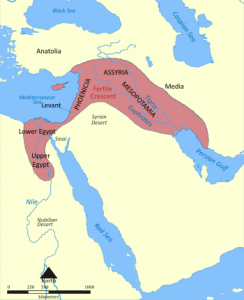
This is a three-part series summarizing human existence from hunter-gatherers to civilization to the modern world we see today.
Civilization
A widely accepted theory to why certain parts of humanity were to make more progress as civilizations – is the “geographical theory” presented by Jared Diamon. To why Europe, the fertile crescent (Sumeria, Akkad etc), India, and China were to be more successful in their progress as early civilizations. Why Europe especially, came to colonize the rest of the world, and not Africa, South Asia, Australia, northern or southern America.
The Pulitzer Prize awarded book “Guns, Germs, and Steel: The Fates of Human Societies”, was published in 1997 by author Jarred Diamond, who is a professor of geography and physiology at UCLA. The book later also became a documentary television series for National Geographic in 2005.
It offers a comprehensive explanation of why human civilization appeared in certain geographical areas and why some civilizations developed more rapidly compared to others. The explanation lies within a framework of predetermined factors, endowments, natural preconditions regarding resources, food, and animals.
As humanity’s first agricultural revolution, the Neolithic Revolution appeared circa 8000 BCE and transferred humanity from a lifestyle of constant hunting and gathering to agriculture and settlements.
Eurasian advantages
Although agriculture came to evolve in different parts of the world independently, Eurasia came to gain an advantage early in human history. An advantage and a head start that was to prove crucial in the progress of civilization according to Diamond.
Diamond noted that Eurasia had the best collection of eatable plants and animals suitable for agriculture and also domestication. With Barley, wheat, rice, goats, sheep, horses, cows, donkeys, and camels.

The Fertile Crescent alone was the home to the eight of the Neolithic crops important in early agriculture. Wild progenitors to emmer wheat, einkorn, barley, flax, chickpea, pea, lentil and bitter vetch. It was also the home of four of the five most important species of domesticated animals; cows, goats, sheep, and pigs.
In contrast with Eurasia, the Native Americans had only maize and teosinte, both of which are low in nutritional value compared to barley and wheat.
Then there is another great advantage with those grains found in Eurasia, since all of which can be stored for longer periods, compared to tropical fruits and other eatable vegetation. This implies that good times and overproduction of food allows for storing and thereby reducing the ill effects during times of underproduction and bad harvests.
These resources and animals provide nutrients and energy, as well as other valuable commodities that can be derived from them. Such as wool, glue, leather, and importantly a way of transport and a source of labor.
The difference is even more striking when comparing the Americas to Eurasia. With Eurasia as a whole domesticating 13 species of large animals. Compared to South America with just one, when counting the llama and alpaca to the same species. And the rest of the world none at all. The sub-Saharan Africans had mostly wild undomesticated animals at their disposal. Some are hard to tame, zebras, others are difficult to breed in captivity, Elephants.
A head start
These endowments provided the people with more sources of food and more productive way of producing these. The surplus of food gave rise to population growth and more densely settled villages and towns.
With higher food productivity and thereby less time devoted to food production, this enables greater possibilities for dedicating valuable time to science, to music and cultural development. To allow greater creativity, artistry, and innovation – indeed a virtues circle in the progress of civilization building.
With a more complex society and increasing economic activity, competition soon arrived. Between peoples and settlements. As devastating conflict and war may be it also spur development, both technological and social.
These early endowments, therefore, led to an advanced state of intellectual, cultural, and material development. Marked by progress in the arts and sciences. The extensive use of record-keeping, including writing, and also the appearance of complex political and social institutions.
This era set the stage for later periods when progress accelerated and differences started emerging between the now civilized world in Eurasia, to be examined in the final part: Wealth of Nations.






















